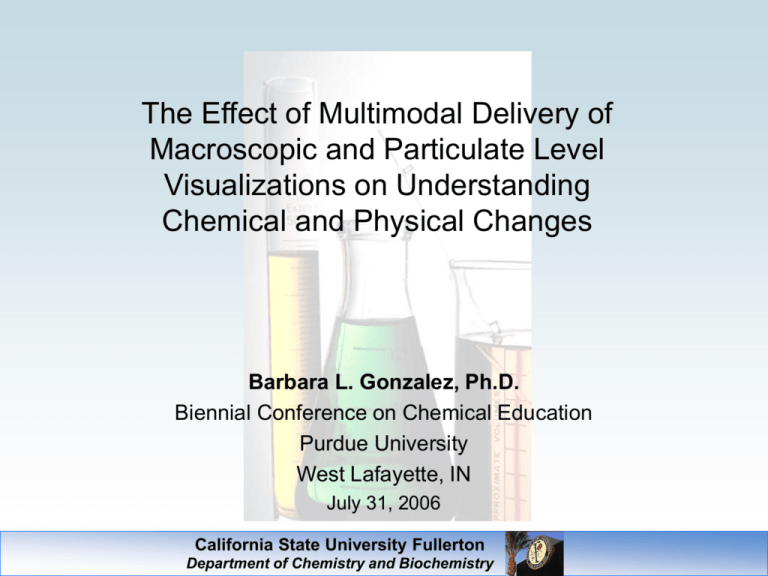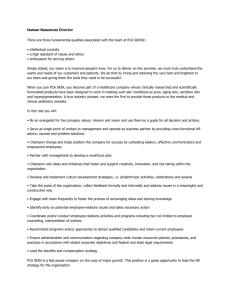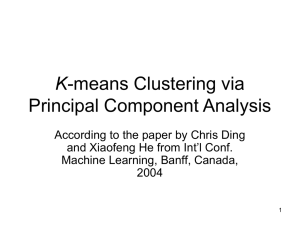PowerPoint Presentation - Department of Chemistry -
advertisement

The Effect of Multimodal Delivery of Macroscopic and Particulate Level Visualizations on Understanding Chemical and Physical Changes Barbara L. Gonzalez, Ph.D. Biennial Conference on Chemical Education Purdue University West Lafayette, IN July 31, 2006 California State University Fullerton Department of Chemistry and Biochemistry Visualization • Visual-Spatial – Ability to mentally manipulate images in three dimensions • • (Coleman and Gotch, 1998) Spatial visualization – Ability to recognize, retain and recall an object when it or parts of it are moved • Spatial orientation – Ability to remain unconfused by changes in the orientation of an object • • (Bodner and Guay, 1997) Imagery – – Ability to elicit a visual representation of a mental model (Gabel,1999; Mathewson, 1999) Visualization and Chemistry • Visual-spatial skills develop from birth and improve with practice – (Lord, 1985; Kosslyn, Margolin, Barrett, Goldknopf and Daly, 1990) • Spatial-perceptual skills are related to performance in a chemistry course and males tend to have better skills in subjects such as science – (Bodner and Domin, in press; Carter, LaRussa, and Bodner, 1987; Coleman and Gotch, 1998) Understanding Changes in Matter • Knowledge is constructed is accordance with cognitive development and social interaction – (Ginsberg and Oper, 1988; Vygotsky, 1969, 1978) • Physical and chemical changes poorly understood by learners of all ages and backgrounds – (Ahtee and Verjola, 1998; Herron, 1993; Johnson, et al., 2000; Solsana, et al., 2003) • Changes in matter in national and state standards as early as elementary school – (NRC, 1996; California Department of Education, 1990) Developmental Patterns in Understanding Chemical Change • Acceptance – The way nature behaves • Displacement of matter – Change is result of matter moving to a new place • Modification – Original substance is in a new form • Transmutation – Original substance is transformed into a new substance • Chemical interaction – New substance is result of dissociation and recombination of atoms and molecules – (Driver, et al., 1985, p.168) Sample • 245 students • Two Institutional Levels – Two Universities • General Chemistry Laboratory • Pre-service Elementary Teachers – One Middle School • Sixth grade science • Two classes • Science lessons taught by one teacher • 2002-2005 Design of Studies TREATMENT Institution University Course Control Still Motion Mixed Pre-Service K 74 28 13 18 8 Teachers Science M ajors Middle School Sixth Grade TOTAL 22 22 33 15 9 11 129 65 22 29 Assessment Subjects PCA Pre-Test N = 133 PCA Post-Test PCA Pre-Test N = 44 PCA Post-Test PCA Pre-Test N = 68 PCA Post-Test N = 245 Research Questions • Is there a significant difference in the ability to distinguish between physical and chemical changes between students who complete a visualization activity and those who receive traditional instruction, as measured by mean scores on PCA — By treatment? — By institution? — By course? • Is there a difference in the frequency of common misconceptions that appear in written explanations of physical and chemical changes PCA • Physical-Chemical Change Assessment – Ten items, two-tier, multiple choice and written explanation – Four types of representations • • • • Macroscopic Particulate Symbolic Visual Which of the following best represents a physical change? A. B. Explain why it represents a physical change. PC Activity • Four modes – Control – Still – Animated – Mixed • Equal number of representations – Macroscopic and particulate – Physical and chemical Macroscopic Level Animated Click box to play movie MP21 Particulate Level Still + SC13 PCA Results Entire Sample mean score(out of 10) PCA pre-test & post-test mean per treatment group(entire sample) 10 9 8 7 6 5 4 3 2 1 0 control still animated Treatments pre-test post-test mixed PCA Gain Factors By Course PCA Ga in Fact or Me a n s By Cou rs e 1 .0 .9 Me a n PCA Ga in Fa ct or .8 .7 .6 .5 .4 .3 .2 .1 0 .0 Mid d le Scho o l Pre Ser vice Te ach e rs Co urs e (F = 3.31, df = 2, p 0.05) Scien ce Majo r s Middle School PCA Results mean score PCA pre -te st & post-te st me ans pe r tre atme nt group in middle school stude nts 10 9 8 7 6 5 4 3 2 1 0 control still Animated Tre atme nt pre-test (F=6.1, df=1, p<0.05) post-test mixed Science Major PCA Results Mean PCA Gain Factor P C A M e a n G a in F a c to r b y T re a tm e n t fo r S c ie n c e M a jo rs 1 .0 0 0 .9 0 0 .8 0 0 .7 0 0 .6 0 0 .5 0 0 .4 0 0 .3 0 0 .2 0 0 .1 0 0 .0 0 C o n tr o l V is u a liza tio n Tre a tm e n t ( t = 1 2 .7 2 , d f = 1 , p < 0 .0 5 ) Science majors who completed the still mode PC Activity earned mean PCA gain factor scores that were significantly higher than the control group Middle School Explanations PCA Explanation Code L, Middle School 100.0 % Frequency 80.0 60.0 40.0 20.0 0.0 1 2 3 4 5 6 7 Question Number Pre Test 8 9 10 Post Test Explanations do not demonstrate rich conceptual understanding Quality of explanations improve with instruction Findings • Trend toward improvement in PCA scores for groups that receive instruction that involves visualization at macroscopic and particulate levels – Pre-Service Teachers and Science Majors earn similar PCA gain factor scores greater than MS – Significant difference in all post test scores for middle school learners who receive instruction that involves visualization – Science majors who receive still mode visualization instruction earn significantly greater mean gain factor scores on PCA • Explanations improve with instruction for all groups Implications • Learners would benefit from actively engaging in real examples as well as visual representations of physical and chemical changes at the macroscopic and particulate levels • Because instruction on physical and chemical change that involves visualizations led to a significant increase in mean PCA gain factor scores for middle school students, early and frequent exposure to is recommended • Science and non-science majors need practice in explaining and representing physical and chemical changes at the macroscopic and particulate levels Acknowledgments National Science Foundation CAREER REC-0133989 Dr. Ingrid Martorell Azin Barzin Maile Bay Cindy Nguyen Dionne Nguyen Adriana Park Chanda Strom Di Trang CSUF CSUF UCSB CSUF CSUF CSUF CSUF CSUF


![See our handout on Classroom Access Personnel [doc]](http://s3.studylib.net/store/data/007033314_1-354ad15753436b5c05a8b4105c194a96-300x300.png)
